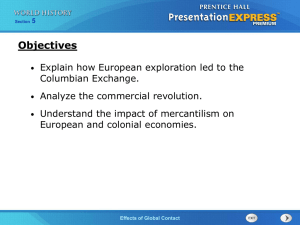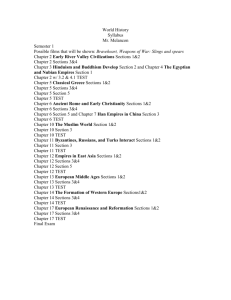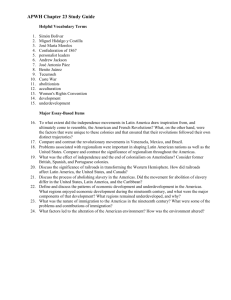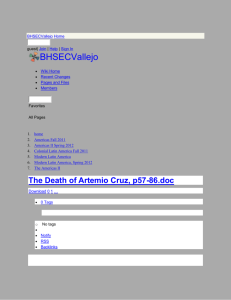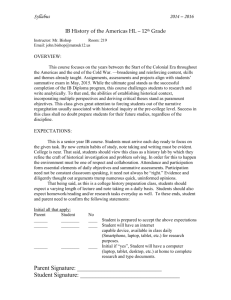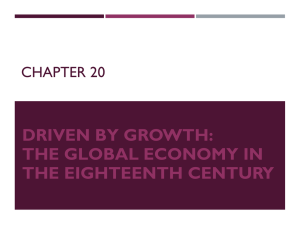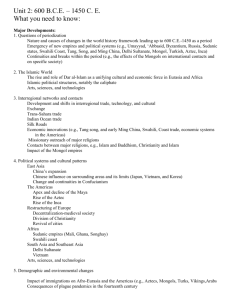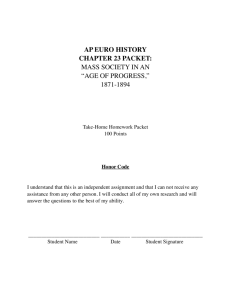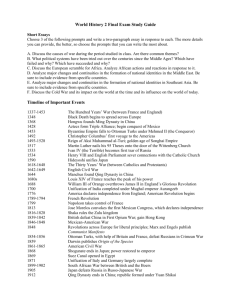Effects of the Industrial Revolution in Western Europe In an Industrial
advertisement
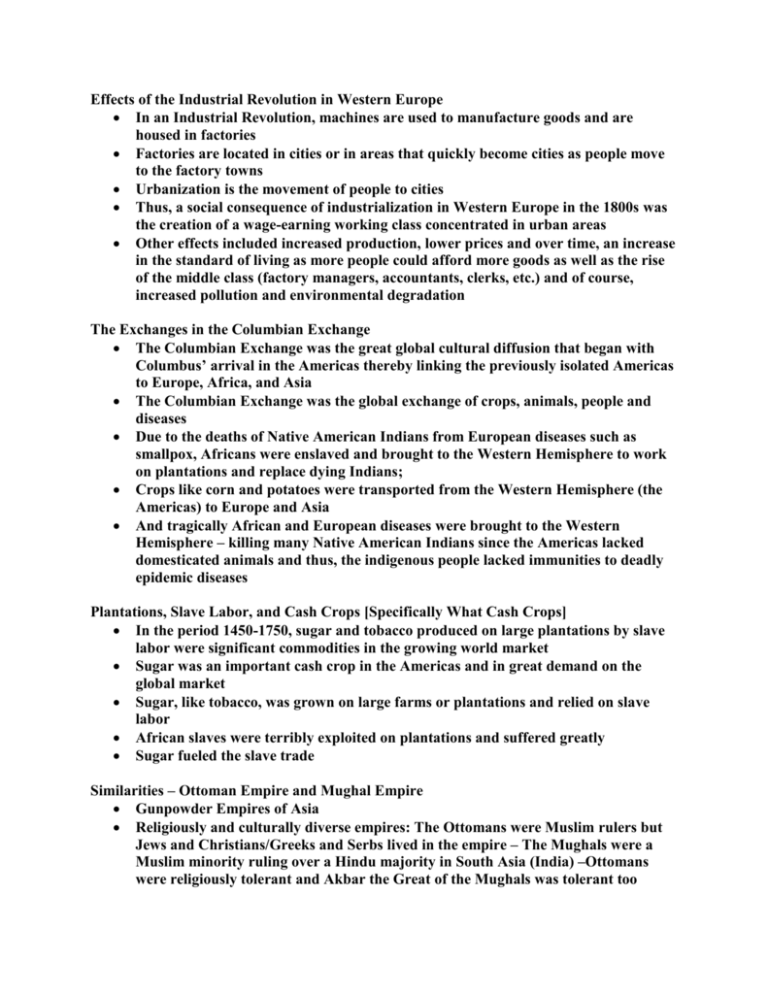
Effects of the Industrial Revolution in Western Europe In an Industrial Revolution, machines are used to manufacture goods and are housed in factories Factories are located in cities or in areas that quickly become cities as people move to the factory towns Urbanization is the movement of people to cities Thus, a social consequence of industrialization in Western Europe in the 1800s was the creation of a wage-earning working class concentrated in urban areas Other effects included increased production, lower prices and over time, an increase in the standard of living as more people could afford more goods as well as the rise of the middle class (factory managers, accountants, clerks, etc.) and of course, increased pollution and environmental degradation The Exchanges in the Columbian Exchange The Columbian Exchange was the great global cultural diffusion that began with Columbus’ arrival in the Americas thereby linking the previously isolated Americas to Europe, Africa, and Asia The Columbian Exchange was the global exchange of crops, animals, people and diseases Due to the deaths of Native American Indians from European diseases such as smallpox, Africans were enslaved and brought to the Western Hemisphere to work on plantations and replace dying Indians; Crops like corn and potatoes were transported from the Western Hemisphere (the Americas) to Europe and Asia And tragically African and European diseases were brought to the Western Hemisphere – killing many Native American Indians since the Americas lacked domesticated animals and thus, the indigenous people lacked immunities to deadly epidemic diseases Plantations, Slave Labor, and Cash Crops [Specifically What Cash Crops] In the period 1450-1750, sugar and tobacco produced on large plantations by slave labor were significant commodities in the growing world market Sugar was an important cash crop in the Americas and in great demand on the global market Sugar, like tobacco, was grown on large farms or plantations and relied on slave labor African slaves were terribly exploited on plantations and suffered greatly Sugar fueled the slave trade Similarities – Ottoman Empire and Mughal Empire Gunpowder Empires of Asia Religiously and culturally diverse empires: The Ottomans were Muslim rulers but Jews and Christians/Greeks and Serbs lived in the empire – The Mughals were a Muslim minority ruling over a Hindu majority in South Asia (India) –Ottomans were religiously tolerant and Akbar the Great of the Mughals was tolerant too Islamic Empires Skilled warriors on horseback – cavalry Descendants of Turks from Central Asia Impact of Crops from the Western Hemisphere on Europe and China Crops from the Americas like potatoes and corn are packed with calories When potatoes and corn from the Americas (the Western Hemisphere) arrived in Europe and China, population increased More crops – more calories – fewer people die from starvation Introduction of Western Hemisphere crops influenced eighteenth-century population trends in both Europe and China Crops from the Americas saved lives in Europe and China How the Industrial Revolution Gave Rise to European Predominance in Late Nineteenth Century Most world historians would agree that the key to European predominance in the world economy during the nineteenth and early twentieth centuries was the Industrial Revolution The Industrial Revolution began in England in 1750 As a result of the Industrial Revolution, machines produced goods in factories and more goods were produced at lower prices Machines produce all kinds of manufactured goods including guns and weapons With mass produced guns, Europeans went forth to conquer lands – in addition, a need for raw materials fueled European conquests leading to European domination of much of the world The Mathematical and Scientific Contributions of South Asia [Think India] The expansion of communication and trade networks in Afro-Eurasia from 600 C.E. to 1450 C.E. resulted in the spread of technological and scientific concepts, such as the decimal and zero It is important to remember that a golden age occurred in the Gupta Empire of South Asia (India) Indian scientists developed the concept of zero, the decimal system, and the concept of infinity as well as a number system that is still used today although referred to as Arabic numerals as the Muslims brought the Indian number system to other lands It is also important to remember that India was a vibrant participant in trade networks particularly the Indian Ocean trading basin where it was the fulcrum of the trade route Thus, increased trade, increased diffusion of products, religions, and ideas The Silk Roads and the Roman and Han Empires Between 200 B.C.E. and 200 C.E., the Silk Roads facilitated commodity trade between the Roman and Han empires The Silk Roads were important overland trading routes connecting China to Southwest Asia (the Middle East) and the Eastern Mediterranean The Silk Roads fostered cultural diffusion as ideas and products spread throughout Eurasia Silk and porcelain from China were desired in diverse markets throughout Eurasia Religions spread on the Silk Roads like Buddhism – in addition, Central Asians often moved goods along the Silk Roads and Central Asian horses were in great demand too Late Nineteenth Century – European Involvement in Africa and China The late nineteenth century (the late 1800s) was the Age of European Imperialism In the late 1800s, Europeans conquered much of the world Industrialization in Western Europe had fueled imperialism (conquest and colonization) as Europeans needed raw materials or natural resources for their factories In the late nineteenth century, European involvement in both Africa and China was characterized primarily by competition among imperialist powers The Scramble for Africa occurred following the Berlin Conference (1884-1885), conference whereby Europeans established rules for the conquest of Africa – one of the rules was to send an army to the claimed land thereby leading to a race or scramble to send troops to Africa to claim land The Impact of the French Revolution on the Haitian Revolution The French Revolution’s ideals of liberty, equality and fraternity inspired individuals around the world If the French could proclaim all men equal in France, then surely all men were equal in other lands Haiti was a French colony in the Caribbean; it was colony with a plantation economy and a large number of African slaves When African slaves heard the words of the French Revolution, they too claimed their equality and freedom The European development that is most closely associated with the revolution in Haiti is the French Revolution – for in Haiti, the slaves rebelled and declared their freedom and independence The Impact of the European Enlightenment on the North and South American Independence The ideas of the European Enlightenment influenced the American and French Revolutions as well as Latin American independence movements - ideas like consent of the governed, natural rights, and popular sovereignty were inspirational The Enlightenment was also known as the Age of Reason and it was a period in the 1700s in Western Europe; in this period, new ideas about government and law developed – ideas like separation of powers (Montesquieu), consent of the governed and natural rights of life, liberty and property (John Locke), religious freedom and freedom of speech (Voltaire), and the social contract (Rousseau) as well as popular sovereignty (the people give government its power through voting) The North and South American independence movements of the late eighteenth and early nineteenth centuries shared revolutionary demands based on Enlightenment political ideas Enlightenment ideas inspired the American Revolution, the French Revolution, and independence movements in Haiti in the Caribbean and Latin America Indeed, the American Constitution is an Enlightenment document beginning with the Enlightenment ideals in the Preamble: “We the People…” Similarities – Christianity and Islam From the founding of each religion, Christians and Muslims shared a belief in a single omnipotent (all-powerful) deity Both Christianity and Islam are monotheistic (one God) faiths influenced by Judaism and therefore are Abrahamic religions as Abraham was the founder of Judaism Christians and Muslims believe in moral and ethical rules for conduct Both have sacred texts: the Bible for Christians and the Qur’an for Muslims Both religions spread on trade routes The Impact of the Mongols on the Rise of Muscovite Russia and the Ottoman Turks In the 1200s and 1300s, the Mongols ruled China, Russia, and Persia In Russia, the Mongols primarily ruled from their beloved steppes – as Russia was close to their homeland The Mongols thought Russia had nothing of value and were primarily interested in the collection of tribute; however, the Mongols had a huge impact on Russia The rise and fall of the Mongolian khanates contributed most to the initial formation of political sates by the Muscovite Russians and the Ottoman Turks In Russia, the Mongols had destroyed the city of Kiev for resisting the tribute and elevated Moscow as the tribute collector – when the Mongol rule weakened in Russia, Moscow was the center of the movement to establish an independent Russia under Moscow’s rule (Muscovite Russia) and in the Southwest Asia (the Middle East), the fall of Mongol rule created a power vacuum thereby allowing the Ottoman Turks to establish an empire in the region Shared Characteristics of the Islamic and Chinese Empires in the Postclassical Period During the Postclassical age, Islamic and Chinese Empires experienced golden ages During the Abbasid Dynasty, Muslims made great advances in math and science During the T’ang and Song dynasties, the Chinese created many important inventions such as the compass, printing, and gunpowder Both empires were also highly urbanized with more individuals living in cities than in other empires and trade flourished These empires experienced Extensive urbanization and maritime trade Impact of Islamic Civilization on Medieval Europe (Think Islamic Spain – Science/Math) While most of Western Europe experienced the Middle Ages with its feudalism and manorialism during the Postclassical period, Spain was conquered by the Muslims The Muslims were experiencing a golden age and so, Spain flourished during the postclassical period compared to Western European societies Spain also served as a cultural bridge that connected Western Europeans to the advances of the Muslims The transmittal of Greek and Arab learning from Muslim lands to Western Europeans had an important effect on medieval Europe as it brought new ideas and new advances in math and science that would lead to new ways of thinking in Western Europe Western Europeans learned of the Muslim golden age during the Crusades but also as a result of the cultural bridge that was Islamic Spain Johannes Gutenberg and the Movable-Type Printing Press Johannes Gutenberg invented the movable-type printing press that transformed Europe Prior to the printing press, books were written by hand and in the long and laborious process, the books produced were few and the prices for books high The printing press produced books faster and by increasing production greatly led to a drop in the prices of books More people could buy books and thus, literacy increased as books could be purchased even by commoners The printing press even spread ideas and if not for the printing press, the Protestant Reformation may have barely impacted Western Europe Characteristics of the Reign of Akbar the Great Akbar the Great was the most significant ruler of the Mughal Empire The Mughal Empire consisted of a Muslim minority ruling a Hindu majority Akbar the Great, however, was very religiously tolerant He removed the jizya or special tax on Hindus; he married a Hindu princess; and he allowed individuals to freely practice their religions His dedication to the ideal of religious tolerance was the most remarkable aspect of his reign The Holy Inquisition The Holy Inquisition was a Catholic court to punish heretics or nonbelievers It was created to track down and punish heretics and religious nonconformists To ensure that Catholics in Catholic countries did not read Protestant books, the Inquisition punished Catholics accused of reading “forbidden” books The Inquisition also punished any Catholic accused of believing or practicing differently than the Church’s teachings required [even earlier than the Reformation] Individuals accused of heresy were imprisoned, tortured and sometimes even killed The Late 1400s and the Incorporation of the Americas into a Broader Network of Exchange 1492 changed world history as the Americas were brought into the global network The incorporation of the Americas in the late 1400s into a broader global network marked the beginning of a new period in world history With Columbus’ accidental arrival in the Americas, the Americas – a land previously isolated from other continents – was brought fully into contact with Europe, Asia, and Africa As Europeans migrated to the Americas to claim lands and Africans were forcibly brought to the Americas to replace a dying Native American Indian population, the Americas were transformed Diseases decimated the indigenous populations; Native American Indians lost control of their lands and often their cultures; and cash crop farming on plantations occurred in the Caribbean islands, Brazil and the southern United States – a plantation system dependent on the forced enslavement of Africans and their descendants The Use of Primary Sources in Historical Studies Primary sources are eyewitness accounts – written by individuals who experienced or witnessed events Primary sources are very valuable in historical studies because they shed light on events and occurrences – though a historian must take into account the author’s point of view European slave traders’ account books are a useful source of evidence for research about the profits of Portuguese and British slave traders in the period 1600–1800 These account books reveal how many African slaves were sold and what profits were gained by slave traders from this tragic and cruel sale of humans Without sources from the time period, it would be difficult to fully reconstruct the events of history Footbinding in China During the Song Dynasty in China, footbinding became fashionable and accepted for women In footbinding, the bones in the woman’s foot are broken and bandaged to create an abnormally small foot Footbinding restricted the movement of women as walking was painful yet if a woman was to marry, it was expected that her feet would be small as this was considered the most erotic part of the female body In a patriarchal society, a woman is subordinate to a man and her value is often in her role as wife and mother and in many cultures, for her beauty – thus a woman is restricted and controlled Both the wearing of corsets in Europe in the nineteenth century and the custom of footbinding in China were designed to restrict women’s freedom of activity. The Opening of Japan and the Meiji Restoration Commodore Perry [sailing for the USA] forced the Tokugawa shoguns to end Japan’s policy of isolationism Wanting refueling stations, Americans ended Japan’s Act of Seclusion Within a few years, the Tokugawa shogunate ended and the Meiji Restoration occurred whereby in 1868, the emperor was restored to power and feudalism was abolished in Japan The Japanese began to modernize and industrialize Ultimately, Japan was more accepting of Western advances than China in the nineteenth century because Japan recognized the need to open up trade relations with the West in order to increase its national power The Japanese government believed that to copy the advances of the west through modernization and industrialization, Japan could gain in strength and power and become an equal among the powers of the West Epidemics in Sixteenth-Century Mesoamerica When the Spaniards accidentally arrived in the Americas, the unknowingly brought deadly germs that decimated the indigenous populations of the Americas Lacking domesticated animals and therefore lacking immunities to deadly diseases that came from animal populations, the Native American Indians died in great numbers In fact, the largest decline in percentage of global population in history occurred as a result of the epidemics in sixteenth-century Mesoamerica Yes, there were other deadly epidemics and populations decimated by disease but remember that 1 in 3 Western Europeans died from Bubonic Plague but 90% or 9 in 10 Native American Indians died from smallpox and other diseases. Disease decimated Mesoamerica (Central America or specifically a region of south of North America that was occupied during pre-Columbian times by peoples such as the Olmecs, Mayans, and Aztecs – groups with shared cultural features Sugar as a Cash Crop In the period between 1600 and 1700, the principal product in the Atlantic trade was sugar Sugar was a valuable cash crop in the Caribbean islands and Brazil It led to the creation of a plantation economy The plantation economy was dependent on African slave trade The sugar trade fueled the slave trade The Impact of the Incan Staple Crop of the Potato on Europe The introduction of the Incan staple crop of potatoes outside South America led to an increase in northern Europe’s population Crops from the Americas like potatoes, corn, and peanuts were highly caloric and easily grew in other lands When these new crops entered Europe, Asia, and Africa, populations were affected In general, the populations of Europe and Africa increased as a result of new crops from the Americas In Africa, the new crops affected population but the Atlantic Slave Trade was also affecting Africa’s population; thus, some historians say that Africa’s population did not increase or decrease in this period due to these two contradictory forces Facts about the Manchus The Qing dynasty founded by the nomadic Manchus was the last dynasty of China The Manchus claimed the Mandate of Heaven or right to rule and adopted NeoConfucianism and the examination system although they did require Chinese men to wear the queue to reveal that they were a subject people In the mid-1600s, the Manchus founded the long-lasting Qing dynasty in China The Qing dynasty lasted from 1644 to 1911 In 1911, the Qing dynasty collapsed – the last dynasty of China collapsed as China became a weak republic and the nation quickly collapsed into civil war Although the early Qing rulers were competent and strong, the rise of Europe and the subsequent Opium Wars greatly weakened China as Europeans claimed spheres of influence in China The First Industry to Be Industrialized in England – Textiles The first Industrial Revolution in great Britain was initially based textiles Textiles: cloth industry The first mechanization and factories in England were textile factories England had great deposits of coal and iron as well as a culture of innovation that fueled industrialization In addition, England experienced an Agricultural Revolution that greatly increased agricultural production thereby creating a workforce for factories – more efficient farms require fewer workers The Few Social Changes that Occurred in Latin America after Independence The wars of independence in Latin America in the early nineteenth century resulted in few changes in social structure Creoles led independence movements in Latin America and were “cautious revolutionaries” in that they wanted independence from Spain and the high government and military posts awarded to peninsulares in colonial times but they did not want a radically restructuring of the class system Creoles did not want land redistribution Thus, Mestizos, Indians and Africans were still disadvantaged as the majority of land was owned by creoles Without land redistribution, the lower classes were still relegated to lives of poverty The Year Russia Ended Serfdom and the Year the United States Ended Slavery Tsar Alexander II of Russia emancipated the serfs in 1861 The Thirteenth Amendment to the U.S. Constitution abolished slavery when the Civil War ended in 1865 Thus, Russia and the United States ended coerced labor in the decade of the 1860s These dreadful systems were finally abolished in the 1860s Serfdom and slavery caused great suffering Belief Systems that Emerged during Political Disorder in China Confucianism and Daoism developed during the “Age of Warring States” The “Age of Warring States” occurred during the Zhou dynasty – the emperor was weak and feudal lords competed for power In this time of suffering, new belief systems emerged from the political disorder Confucianism and Daoism, these new belief systems, did not worship a deity and remained primarily regional beliefs Confucius believed that peace and harmony depended on order and inferiors obeying superiors; Lao-tzu believed that peace and harmony depended on living naturally The Major Feature of the Neolithic Revolution in the Middle East A major feature of the Neolithic Revolution in the Middle East was the establishment of sedentary village communities Of course, during the Neolithic Revolution, some people learned to farm and domestic animals Agriculture led to sedentary lifestyles and end to nomadism Permanent settlements were established and a reliable source of food existed Yet agricultural communities also gave rise to patriarchy (male dominance), class divisions, and epidemic diseases Major Difference between the Social Structure of Han China and That of Classical India The Chinese placed bureaucrats rather than priests at the top of the social hierarchy In Classical India, the Hindu caste system largely determined a person’s status In the caste system of Classical India, priests, warriors, merchants and farmers were castes (from highest to lowest) and untouchables or outcastes belonged to no caste and faced discrimination and exploitation In Han China, the examination system determined government service and afforded high status The scholar-gentry (the men who passed the examinations) were highly privileged and had high status in society Judaism The world’s first, lasting monotheistic and ethical religion A religion that has influenced Christianity and Islam Judaism is based on the belief in a covenant between God and the Hebrew people The Jewish people must obey God’s commandments and in turn will be blessed; if commandments are not obey, difficulties can arise Judaism teaches the belief in a single, omnipotent deity The Turks in Anatolia The Turks were a group of people who entered the Middle East in the eleventh century C.E. and came to dominate most of Anatolia Anatolia is the Asian part of the modern-state of Turkey The Turks in the 1300s founded the Ottoman Empire The most significant ruler of the Ottoman Empire was Suleiman the Magnificent The Turks were Muslims The Japanese Feudal Hierarchy Under the Japanese system of feudalism after 1600, the emperor served as the symbol of authority while real power was held by shogun The shogun was the most powerful lord in feudal Japan The emperor reigned but did not rule in that all political decisions were made by the shogun The feudal hierarchy from top to bottom of Japan was: shogun, daimyo (lords), samurai (knights), and peasants The last feudal shogunate in Japan was the Tokugawa shogunate – lasting from 1603 to 1867 – with its Act of Seclusion or no foreigners in and no Japanese out, excluding the port at Nagasaki where the Chinese and Dutch could trade Buddhism The founder of Buddhism developed a religion centered on the elimination of desire and suffering Siddhartha Gautama was an Indian prince in the 500s B.C.E. – although raised a Hindu, he came to believe that life had suffering but suffering could end He formulated the Four Noble Truths, the Noble Eightfold Path, and the concept of nirvana or an end of suffering Like Hindus, Buddhists accept the ideas of Karma and Dharma However, Buddhists do not accept the Hindu caste system and provide monastic opportunities for women The Mughals The Mughals founded a Muslim Empire in Hindu India The Mughals were a Muslim minority ruling a Hindu majority The Mughals were originally from Central Asia In this system in which an Islamic minority ruled over a Hindu majority, some Mughal rulers were tolerant like Akbar the Great Akbar the Great eliminated the jizya or tax on Hindus or non-Muslims, married a Hindu princess and was religiously tolerant Define the Concept of Extraterritoriality The concept of extraterritoriality involves the privilege of foreigners to be tried in their own courts rather than by courts of the country where they reside Extraterritoriality was one of the provisions of the Treaty of Nanjing, the treaty that ended the Opium War The British living in China under extraterritoriality would be tried in British courts in China Thus, the Chinese authorities had no power over foreigners in China; foreigners could largely do as they pleased China was also carved into spheres of influence; Europeans often controlled the ports of China thereby controlling trade Define the Concept of Nationalism Nationalism is the desire by a large group of people (such as people who share the same culture, history, language, etc.) to form a separate and independent nation of their own Nationalism a feeling that people have of being loyal to and proud of their country often with the belief that it is better and more important than other countries Nationalism can be a force that unites people of the same culture into one nation as in German unification and Italian unification or nationalism can be a force that divides a people – like nationalist movements in multiethnic empires Rebellious ethnic minorities in the Russian, Ottoman, and Austro-Hungarian Empires during the late nineteenth century were motivated primarily by nationalism Nationalists can be independence leaders or separatists or individuals who think their cultures and nations are superior – it all depends on the historical forces creating the nationalist The Meiji Restoration in Japan The policies of the Meiji reformers brought about the promotion of rapid industrialization in Japan After Commodore Perry ended the Tokugawa’s Act of Seclusion and isolationist policies, a new government was created in Japan and a new period of modernization and industrialization was initiated During the Meiji Restoration, the emperor was restored to power and feudalism was abolished as Japan began to modernize and industrialize Due to the Meiji Restoration, Japan was able to compete with the powers of the West and become join the ranks of the imperialist powers dominating much of the world The Status of Merchants in Han China In Han China, merchants and traders were placed in a lower social class than farmers and artisans Merchants had low status In Han China, education was greatly valued and thus the respect accorded the Confucian scholar-gentry and land was valued and thus the respect accorded to even peasants for they worked the land Merchants were seen as social parasites as they profited from the labor of others Merchants also violated filial piety (to honor and respect parents and ancestors) as they often traveled far from parents when conducting business Define the Concept of the Mandate of Heaven The Mandate of Heaven is the belief in the emperor’s right to rule given by the gods The concept of the Mandate of Heaven was established during the Zhou dynasty and in the Zhou dynasty, the Mandate of Heaven meant that rulers were allowed to keep their power if they ruled justly and wisely If there was peace and prosperity, then the ruler clearly had the Mandate of Heaven If there was lots of warfare, famine, floods, and/or epidemics, the ruler clearly had lost the Mandate of Heaven The Mandate of Heaven justified rebellion in that if the Mandate was clearly lost, the people had the right of rebellion and a new dynasty would be founded – thus, the existence of a dynastic cycle in China Characteristics of Pre-Islamic Arabia Pre-Islamic Arabia was polytheistic with its belief in many gods and animistic with its belief in spirits in nature The majority of people in pre-Islamic Arabia were nomads as most of Arabia is desert although there were merchants as Arabia was on important trade routes Pre-Islamic Arabia is best characterized as pastoral nomadic Animals were raised (pastoralism) although agriculture was difficult due to the desert lands Arabia was an important destination in Indian Ocean trade The Sunni and Shi’a Divide The Sunni and Shi’a divide is a religious schism that stemmed from disputes over legitimate succession of leadership after the death of its key or founding figure When Muhammad died, he failed to pick a successor to rule over the Islamic umma or community Without a successor being selected by Muhammad, divisions arose over who was the rightful ruler of the umma The majority of Muslims believed that any pious or worshipful Muslim man could rule the umma A minority of Muslims, however, believed that only a descendant of ‘Ali, the Prophet’s son-in-law could rule Characteristics of Pre-Columbian Civilizations in the Americas Many societies in pre-Columbian Americas were considered unusual because they reached an advanced state of civilization without developing systems of writing The Americas lacked writing and lacked domesticated animals – largely due to isolation Yet pre-Columbian societies flourished While Mayas had a fully developed writing system, the Aztecs and Incas did not yet these civilizations flourished too Usually, writing is a key component of a civilization but in the Americas, great advances occurred without writing Characteristics of the Abbasids The second Islamic dynasty Overthrew the Umayyad dynasty with support from Mawali (non-Arab Muslims) and Shi’a During the Abbasid caliphate, a golden age occurred with great advances in math and science The Abbasid were more decentralized than the Umayyad And the Abbasid never conquered Islamic Spain Trade and Urbanization Trade and urbanization go hand in hand The most significant cause of the growth of cities in Afro-Eurasia in the period 1000 to 1450 was increased interregional trade When there is trade, merchants will congregate in towns that often become cities due to the bustling activities and needs of the traders Trading centers – often ports – become cities Think about some of the most significant cities in the world today – these cities were once great centers of trading activity and still are great centers of trading activity Why the Incas Maintained Storehouses of Agricultural Surpluses The rain does not always fall; the sun does not always shine; and the crops do not always grow It is said to save for a rainy day but really humans must save for a non-rainy day The Inca government maintained storehouses of agricultural surplus for public relief and social welfare – to help people in times of drought and to prevent famine The Incas also maintained storehouses to help the sick, the widow, the orphan, and the poor Storehouses ensured that the people of the empire thrived even in difficult times The Last Prophet According to Islam Muhammad is the last prophet according to Islam Muhammad is considered the “Seal of the Prophets” Muslims believe that there will be no prophets after Muhammad Thus, Muhammad is very important Muhammad provided the final revelations from God according to Muslims Merit Examinations in T’ang China China under the T’ang dynasty filled positions in the bureaucracy by means of merit examination A merit examination determines the competence of the candidate Therefore, in T’ang China, a man received a government post by passing a rigorous examination based on Confucianism and Chinese history By passing the examination, the man became a scholar-gentry and was highly respected The examination system was open to all men and allowed for a modest measure of social mobility as it was more difficult for a poor man to train for the examination than a rich man but a promising peasant could be financially supported by his village – after all it is good to people in high positions
